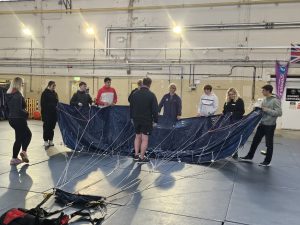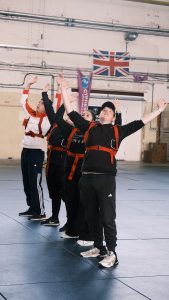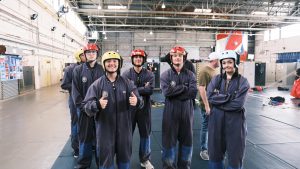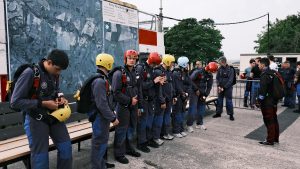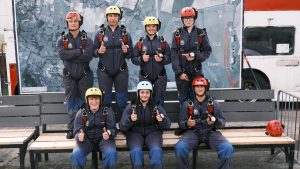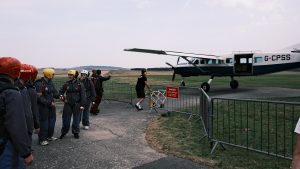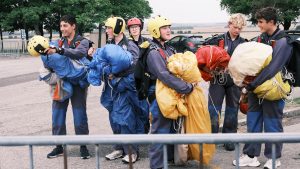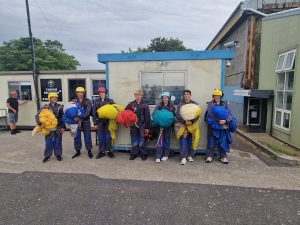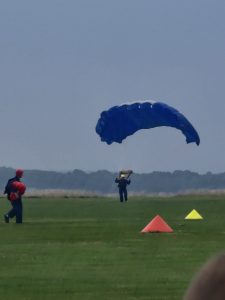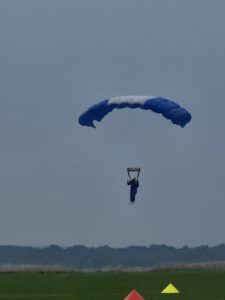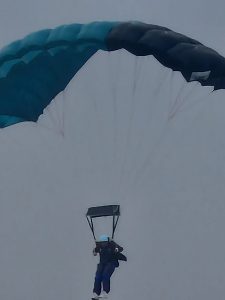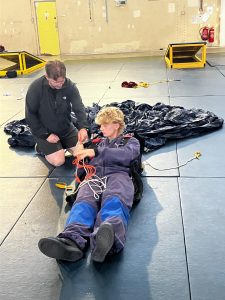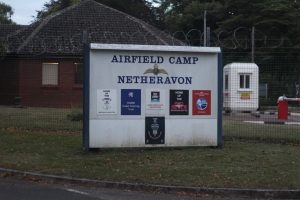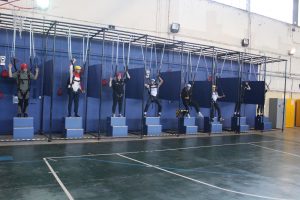On August 28th, 2024, eight young cadets, aged 16 and 17, from the Wallisdown, Bournemouth, and Poole Detachments of the Dorset Army Cadet Force embarked on a journey they would never forget. Their adventure? A daring leap of faith into the world of skydiving.
The journey began at 6 PM on a Friday evening, with the cadets brimming with excitement and anticipation as they boarded the minibus. Whispers filled the air, speculating about the heights they would reach, the gear they would wear, and even what they would say as they plunged through the air. The atmosphere was electric, charged with a mixture of nervous energy and thrilling curiosity.
An hour later, the bus arrived at Airfield Camp, Neveravon, home of the Army Parachuting Association. The location itself whispered of adventure, and the cadets’ excitement reached a fever pitch. What awaited them tomorrow?
Their temporary home consisted of three portacabins converted into bunkhouses, each housing four sets of bunk beds. The male cadets occupied one cabin, the adults another, and the female cadets the last.
With their stomachs grumbling, the cadets were treated to a pizza dinner at Pizza Hut. The conversation inevitably turned to the next day’s events, their anxieties and anticipation bubbling over. Finally, well-fed and exhausted from the day’s journey, they returned to camp for a much-needed rest, their dreams filled with visions of soaring through the air.
Training Day: Facing Fear and Embracing the Challenge
The next morning, just a stone’s throw away from their accommodation, stood the massive hangar and training facilities. An air of seriousness settled over the cadets as they booked in for their training, their voices seemingly lost in the stark silence.
After a quiet breakfast, paperwork was checked and signed, and the course instructor, John, was introduced. The cadets, now under the watchful eye of John, entered the Army Adventurous Training Air Wing, a large hall filled with rows of lockers and covered in thick matting. They made their way to Classroom 1, the scene of their first training session.
The training began with theoretical lessons, providing the cadets with a comprehensive understanding of what to expect during their jumps, the potential hazards, and the vital skills they would learn throughout the course. Theory complete, they moved out to the training wing, where they were introduced to the canopy, or parachute, and the complex components that made up the entire rigging.
After a hearty lunch, the cadets returned to the Air Wing for the afternoon session. This time, the focus was on mastering the landing. The cadets were taught how to execute the PLF (Parachute Landing Fall) technique, a crucial skill designed to absorb the impact of landing at high speeds.
They learned to keep their knees and feet together, allowing their body to buckle upon impact while rotating to the side using their hips and legs to disperse the force.
Next, they moved on to practicing entering and exiting the aircraft. The training wing featured large openings that simulated aircraft doors. They were instructed on how to enter, connecting their tethers and ensuring they were secure. With their instructor by their side, they shuffled forward to the front of the “plane,” ready for the next stage.
Finally, the moment they had all been waiting for – the simulated exit. The command “in the door” signalled the time to move to the opening, lowering their legs and preparing for the jump. Their right arm rested against the tail section, their left hand on the floor of the opening. Their eyes fixed on the instructor, they waited for the final command.
“GO!” The instructor shouted, and the cadets pushed away from the plane, arching their backs, and began counting “1000, 2000, 3000, 4000.” Next came the crucial canopy checks. They had to verify that the canopy was large, rectangular, and free from damage. If all checks passed, they moved on to the control checks, using the toggles to flare the cords.
However, if any of the checks failed, they would need to conduct malfunction drills, identifying and pulling the cut-away cord and the reserve chute cord. The checks were repeated until they were confident in their actions.
As the day drew to a close, the instructor bid farewell to the cadets, his eyes gleaming with anticipation for the jump day. The cadets, their faces etched with a mix of excitement and apprehension, returned to the minibus, their conversations filled with the lessons they had learned. Even the ACF instructors joined in the playful banter, asking the cadets to check their seatbelts with the now-familiar question: “Is it big? Is it rectangular? And is it free from damage?”
A hearty dinner at the Harvester provided much-needed fuel for the cadets, their minds brimming with the vast amount of information they had absorbed. They had all excelled, surpassing expectations. Back at the camp, some of the less confident cadets surprised everyone by practicing their PLF techniques on the grass outside, demonstrating their unwavering commitment to mastering the skills they would need.
Jump Day: Taking the Plunge
The air crackled with anticipation as we arrived back at the Air Training Wing on Sunday. It was “Jump Day,” a day we’d all been eagerly awaiting. The cadets, buzzing with nervous energy, were undergoing a final round of revision and refresher training led by the seasoned instructor, John. His stern yet reassuring presence calmed our nerves as he drilled into us the crucial safety protocols and procedures.
After the training session, a palpable tension filled the air as we waited for the plane manifest to be posted. We all waited to see their names scrawled on the board, this would be a visible confirmation of their impending leap. However, the weather conspired against us. The wind picked up and the cloud cover grew. For those under 18, the maximum permissible wind speed for jumping was a mere 15 knots. Our hopes began to dwindle as we realized the weather was not playing ball.
Time seemed to stretch endlessly as we sat around, fingers tapping impatiently, waiting for the elusive green light. Our eyes scanned the sky, searching for any sign of a break in the clouds, any hint of a change in the wind’s mood. But the drop zone remained closed, a cruel reminder of our thwarted dreams.
Disappointment hung heavy in the air as we boarded the minibus. The silence spoke volumes. We had come so close, only for the Cadets to be denied the exhilarating rush of freefall. Yet, a glimmer of hope remained. We had already scheduled a return visit for the following Sunday, a new opportunity to conquer the sky. And with this small ember of optimism burning bright, we headed home, their minds already racing with anticipation for the next chance to take the plunge.
Jump Day: Taking the Plunge Take Two
Sunday dawned, and the day of the jump was finally here. The cadets returned to the Air Training Wing for a revision session, refreshing their knowledge and preparing themselves for the real deal. The atmosphere was a mix of nervous anticipation and a quiet determination.
The excitement reached fever pitch as the Cadets donned their overalls, chose helmets, and got weighted. The reality of their upcoming jump sunk in, leaving them a mix of excitement and nerves. Their individual parachutes were allocated and signed for, marking the start of this momentous journey.
Led to the holding area outside, the Cadets were met by their proud parents, cameras in hand, capturing this momentous occasion. The sound of the approaching aircraft silenced the gathering as anticipation reached its peak. After thorough checks, the Cadets boarded the aircraft, giving nervous waves to their families and instructors. The sight of their determined faces, filled with anticipation, was a testament to the hard work and dedication they poured into this endeavour.
The aircraft taxied to the runway, the engines roared, and the Cadets were airborne, heading towards their Drop Point. The instructors watched anxiously from the ground, counting each cadet as they exited the plane.
As they sat inside of the plane, the world below them a tapestry of green fields and rolling hills, each cadet faced their own personal battle with fear. But they had come this far, pushed their comfort zones, and embraced the challenges. And as they took that leap of faith, soaring through the air, they knew they were not only conquering their fears but also embarking on a journey that would forever change them.
The experience was not just about the thrill of the jump. It was about the lessons learned, the bonds forged, and the confidence gained. It was about pushing personal boundaries and proving to themselves that they were capable of achieving things they never thought possible.
Just like proud parents, we watched, counted with a sense of relief as the last cadet jumped, and then anticipation turned to pride as each cadet descended gracefully as they landed safely back on the ground, they did so not only with a sense of accomplishment but also with a newfound understanding of their own strength and resilience. The cadets had embraced the challenge, conquered their fears, and soared through the skies, leaving behind an unforgettable adventure that would stay with them forever. We could not have been prouder of each Cadet. They all faced unique challenges during the course, showcasing their resilience and determination.
The Teamwork
The strong bond they formed led them to promise to pay for a jump with Bartlett when she received the go-ahead from her doctor, solidifying their commitment to experiencing this thrill together.
This skydiving adventure was a testament to the Cadets’ dedication, perseverance, and the power of teamwork. It was a journey filled with challenges, triumphs, and an unforgettable sense of accomplishment.

